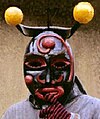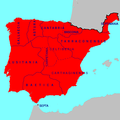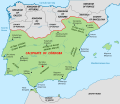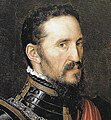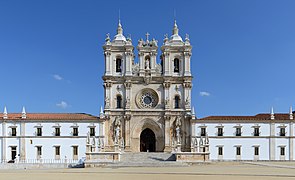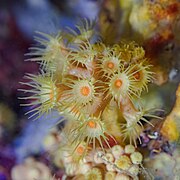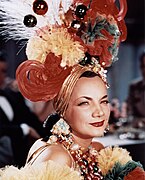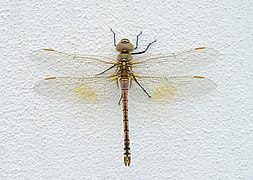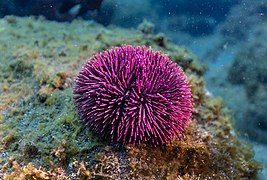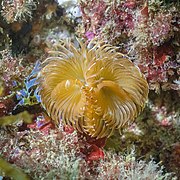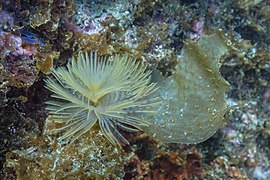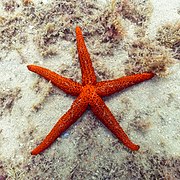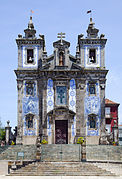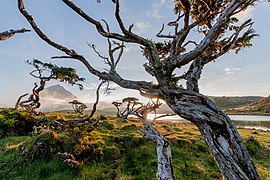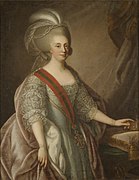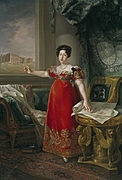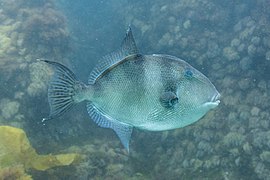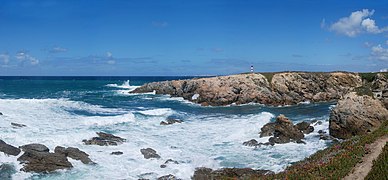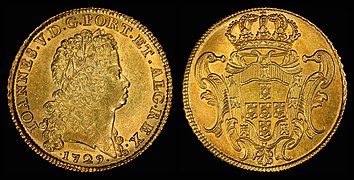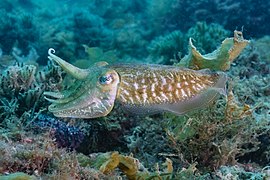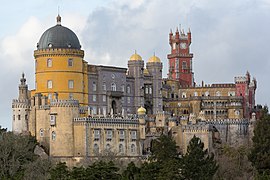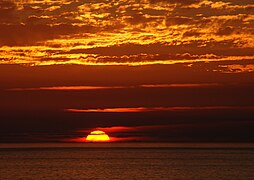
Back بوابة:البرتغال Arabic دەروازە:پورتوگال CKB Portál:Portugalsko Czech Portal:Portugal German Portal:Portekiz DIQ Portal:Portugal Spanish Atari:Portugal Basque Portail:Portugal French Portal:Portugal Galician Պորտալ:Պորտուգալիա Armenian
Welcome to the Portugal portal  Portugal, officially the Portuguese Republic, is a country located on the Iberian Peninsula in Southwestern Europe, whose territory also includes the Macaronesian archipelagos of the Azores and Madeira. It features the westernmost point in continental Europe; its mainland west and south border with the North Atlantic Ocean; and in the north and east, the Portugal-Spain border, which constitutes the longest uninterrupted border line in the European Union. Its archipelagos form two autonomous regions with their own regional governments. On the mainland, the Alentejo region occupies the biggest area but is one of the least densely populated regions of Europe. Lisbon is the capital and largest city by population, and it is also the main spot for tourists alongside Porto, the Algarve, and Madeira. As one of the oldest countries in Europe, its territory has been continuously settled and fought over since prehistoric times. The territory was inhabited by the Celtic and Iberian peoples, such as the Lusitanians, the Gallaecians, the Celtici, the Turduli, and the Conii. These peoples had some commercial and cultural contact with the Phoenicians, ancient Greeks, and Carthaginians. It was later ruled by the Romans, followed by the invasions of Germanic peoples together with the Alans and later the Moors, who were eventually expelled during the Reconquista. First founded as a county within the Kingdom of León in 868, Portugal formally became an independent kingdom with the Treaty of Zamora in 1143. During the 15th and 16th centuries, Portugal led the Age of Discovery and established one of the longest-lived maritime and commercial empires, becoming one of the main economic and political powers of the time. By the early 19th century, events such as the 1755 Lisbon earthquake, the country's occupation during the Napoleonic Wars, and the resulting independence of Brazil in 1822 led to a marked decay of Portugal's prior opulence. This was followed by the civil war between liberal constitutionalists and conservative absolutists over royal succession from 1828 to 1834. The 1910 revolution deposed Portugal's monarchy and established the democratic but unstable Portuguese First Republic, later superseded by the authoritarian regimes of Ditadura Nacional (National Dictatorship) and Estado Novo (New State). Democracy was restored after the Carnation Revolution (1974), ending the Portuguese Colonial War and eventually losing its remaining colonial possessions. (Full article...) Selected article - This is a Featured article, which represents some of the best content on English Wikipedia.
 The flag of Portugal (Portuguese: Bandeira de Portugal) is the national flag of the Portuguese Republic. It is a rectangular bicolour with a field divided into green on the hoist, and red on the fly. The lesser version of the national coat of arms of Portugal (armillary sphere and Portuguese shield) is centered over the colour boundary at equal distance from the upper and lower edges. Its presentation was done on 1 December 1910, after the downfall of the constitutional monarchy on 5 October 1910. However, it was only on 30 June 1911, that the official decree approving this flag as the official flag was published. This new national flag for the First Portuguese Republic, was selected by a special commission whose members included Columbano Bordalo Pinheiro, João Chagas and Abel Botelho. The conjugation of the new field color, especially the use of green, was not traditional in the Portuguese national flag's composition and represented a radical republican-inspired change that broke the bond with the former monarchical flag. Since a failed republican insurrection on 31 January 1891, red and green had been established as the colours of the Portuguese Republican Party and its associated movements, whose political prominence kept growing until it reached a culmination period following the Republican revolution of 5 October 1910. In the ensuing decades, these colours were popularly propagandised, green represented the hope of the nation and the colour red represented the blood of those who died defending it, this happened to endow them with a more patriotic and dignified, therefore less political, sentiment. The sphere and shield in the middle of the current flag are an integral part of the design, which has historically been centred on the royal arms, usually over fields of blue and white. Since the country's foundation, the standard developed from the blue cross-on-white armorial square banner of King Afonso I, through progressively more complex designs, which did incorporate green and red, to the liberal monarchy's arms over a blue-and-white rectangle. In between, major changes associated with determinant political events contributed to its evolution into the current design. (Full article...)General imagesThe following are images from various Portugal-related articles on Wikipedia.
Selected quote -"I will resign to prevent the country from falling into a political swamp."
António Guterres, former Prime Minister
This is a Good article, an article that meets a core set of high editorial standards.
Póvoa de Varzim (Portuguese pronunciation: [ˈpɔvu.ɐ ðɨ vɐɾˈzĩ] ) is a Portuguese city in Northern Portugal and sub-region of Greater Porto, 30 km (18.6 mi) from its city centre. It sits in a sandy coastal plain, a cuspate foreland, halfway between the Minho and Douro rivers. In 2001, there were 63,470 inhabitants, with 42,396 living in the city proper. The city expanded southwards, to Vila do Conde, and there are about 100,000 inhabitants in the urban area alone. It is the seventh-largest urban agglomeration in Portugal and the third largest in Northern Portugal. Permanent settlement in Póvoa de Varzim dates back to around four to six thousand years ago. Around 900 BC, unrest in the region led to the establishment of Cividade de Terroso, a fortified city, which developed maritime trade routes with the civilizations of classical antiquity. Modern Póvoa de Varzim emerged after the conquest by the Roman Republic of the city by 138 BC; fishing and fish processing units soon developed, which became the foundations of the local economy. By the 11th century, the fishing industry and fertile farmlands were the economic base of a feudal lordship and Varzim was fiercely disputed between the local overlords and the early Portuguese kings, which resulted in the establishment of the present day's municipality in 1308 and being subjugated to monastic power some years later. Póvoa de Varzim's importance reemerged with the Age of Discovery due to its shipbuilders and merchants proficiency and wealth, who traded around the globe in complex trade routes. By the 17th century, the fish processing industry rebounded and, sometime later, Póvoa became the dominant fishing port in northern Portugal. (Full article...)Selected Biography -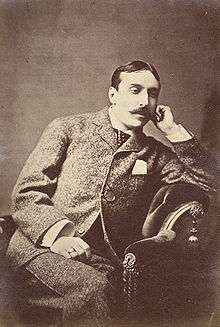 Selected picture - A Portuguese F-84 being loaded with amunition in the 60's, at the Luanda Air Base, during the Portuguese Colonial War
Did you know -
Portugal topicsPortugal lists
SubcategoriesRecognized content
Featured articles
Former featured articlesFeatured listsFormer featured listsGood articles
Former good articlesDid you know? articles
Featured pictures
Former featured portalsIn the News articles
Main page featured articles
Picture of the day pictures
Featured topicsNew articlesThis list was generated from these rules. Questions and feedback are always welcome! The search is being run daily with the most recent ~14 days of results. Note: Some articles may not be relevant to this project.
Rules | Match log | Results page (for watching) | Last updated: 2024-07-12 22:01 (UTC) Note: The list display can now be customized by each user. See List display personalization for details.
Things you can doRelated PortalsRelated WikiProjects
Associated WikimediaThe following Wikimedia Foundation sister projects provide more on this subject:
Discover Wikipedia using portals |
© MMXXIII Rich X Search. We shall prevail. All rights reserved. Rich X Search












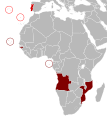






![Image 19Maios celebration in Madeira island [1] (from Culture of Portugal)](http://upload.wikimedia.org/wikipedia/commons/thumb/e/e1/2011-03-05_03-13_Madeira_045_Santana_%285543431418%29.jpg/120px-2011-03-05_03-13_Madeira_045_Santana_%285543431418%29.jpg)







